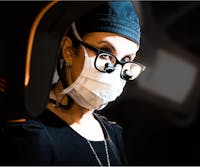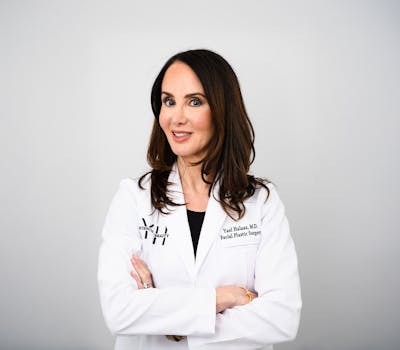Facelift
This woman wanted a natural result from her facelift to correct the effects of aging and gravity without looking “too pulled”.
View GalleryDr. Yael Halaas brings over 20 years of expertise in facial plastic surgery, specializing in facelifts in NYC. With a reputation for the highest patient satisfaction and the lowest complication rates on the East Coast, Dr. Halaas is recognized as a leader in the field. As a double board-certified surgeon in Otolaryngology and Facial Plastic and Reconstructive Surgery, her artistic precision and mastery of the latest techniques set her apart. Patients appreciate not only her elite training from institutions like Columbia and Cornell but also her genuine, compassionate approach that makes them feel truly cared for and confident in her skilled hands.

A facelift is a surgical procedure designed to reduce the visible signs of aging on the face and neck. By tightening sagging skin, lifting facial muscles, and smoothing deep wrinkles, a facelift can restore a more youthful and refreshed appearance. This procedure enhances facial contours, reduces jowls, and rejuvenates the overall look, helping you regain confidence with natural-looking, long-lasting results.
Facelift surgery in NYC is more than a cosmetic procedure; it’s a powerful way to restore confidence and reveal a refreshed, younger-looking version of yourself. The result? A naturally youthful look that can take up to 10 years off your appearance, all while preserving your unique expression and beauty.
Beyond aesthetics, many patients find that a facelift also improves how they feel about themselves day to day, whether that’s seeing a more energetic reflection in the mirror or feeling more confident in social and professional settings.
With just one surgery, you can achieve:
Facelift
This woman wanted a natural result from her facelift to correct the effects of aging and gravity without looking “too pulled”.
View GalleryFacelift
Facelifts can improve the jowls and marionette lines that make us look older and angry. The results look natural and refreshed.
View GalleryFacelift
A Facelift can smooth out the jawline, take years off the face & neck and leave the patient looking natural & refreshed.
View GalleryCandidates for a facelift are usually men or women who would like to achieve a dramatically more youthful appearance. The typical age for a facelift ranges between 40 and 60 years, although individuals who are younger or older may also be good candidates. Candidates for a facelift in NYC should meet the following requirements:
After two decades of surgical experience, Dr. Halaas has conducted over 1200 "Local Lifts" (facelifts under local anesthesia), with the highest satisfaction and lowest complication rate on the East Coast. Dr. Yael Halaas is highly experienced in facelifts of all types, combining her artistic background with the latest surgical techniques.
As a double board-certified plastic surgeon in Otolaryngology and Facial Plastic and Reconstructive Surgery, she is the number one female facial plastic surgeon on the East Coast. Her authority and expertise in the field of facial plastic surgery are the reasons she is a trusted opinion leader and surgeon when it comes to facelifts and other surgical procedures.
Educated at prestigious institutions such as Columbia University and Cornell University, Dr. Halaas blends elite training with a warm, honest, and compassionate approach that patients deeply value. Her care goes beyond technical excellence; patients consistently feel seen, heard, and confident in her hands.

Dr. Halaas performs different types of facelifts in NYC to achieve your aesthetic needs and goals.
This less invasive facelift is performed under local anesthesia and targets more precise areas, requiring smaller incisions. Small “S” shaped incisions are made near the hairline by the ears. Using these incisions, the mid and lower areas of the face (the cheeks and jawline) are lifted and sculpted. There is less surgical trauma with a mini facelift, resulting in a shorter recovery period. Because it has a shorter procedure time and faster recovery, the mini facelift is often called by the nickname, “the weekend lift.”
A deep plane facelift is performed with general anesthesia and addresses the underlying structure of the skin–muscle and connective tissue called the SMAS (Superficial Musculoaponeurotic System). This network of tissue lies over the facial muscles, forming the framework and structure of the face. Dr. Halaas will make incisions around the ear, then use these to tighten and lift the SMAS, working in a wider range of tissue than other facelifts to achieve more dramatic improvements. The four ligaments that anchor the facial muscles downward are released to beautifully lift the facial features.
The SMAS facelift is similar to a deep plane facelift. It addresses and tightens the SMAS (Superficial Musculoaponeurotic System). This network of muscle and connective tissue lies beneath the skin and above the facial muscles. Incisions will be made around the ear and used to lift, tighten and address the SMAS, focusing on the muscles in the jaw area that have loosened and caused sagging. Excess skin and fat are removed to achieve a more youthful appearance.
Dr. Halaas created the Local Lift®, a facelift procedure less traumatic than a full facelift that achieves excellent results. The Local Lift has fewer risks and is customized for each patient. This procedure can lift sagging cheeks, reduce lines and wrinkles, and tighten the neck muscles.
Before your facelift in NYC, Dr. Halaas will provide instructions to follow to help prepare you. This will include a list of medications and supplements to avoid, such as aspirin or other anti-inflammatory drugs that thin the blood.
Arrange in advance to have a friend or family member drive you home after your procedure who can help you that night and the following day.
All procedures are performed by Dr. Halaas in her AAAASF-accredited surgical facility in NYC. During your procedure, you will have either local anesthesia, the most common anesthesia required with Dr. Halaas for facelifts, or general anesthesia. Based on the type of facelift you’re having, she will make incisions near the hairline around the ears, and use these incisions to tighten and reposition the underlying muscles, lifting the features and trimming away excess skin. Once the lift is complete, she will close the incisions carefully to keep scarring at an absolute minimum.
Dr. Halaas puts an emphasis on safety while in surgery, and provides detailed post-op instructions in order to quicken the recovery time for her patients.
After your procedure is complete, Dr. Halaas will provide you with a light face wrap that needs to be worn for a week. You will be able to return home with a friend or family member. Dr. Halaas will give you a homeopathic prescription to reduce swelling and bruising, which will last several days to a week. She will see you the next day to check on your healing. The wrap can be taken off, and most patients can return to light work within 1-2 weeks. All stitches will be removed within 10-14 days. Wait for 4-6 weeks before you return to vigorous activity.
Facelift scars are discreetly placed in the hairline and around the ears. They generally heal within six months, fading from pink to a pale line, with full fading occurring over 1–2 years.

A traditional facelift, also known as a rhytidectomy, addresses signs of aging in the bottom two-thirds of the face, including the cheeks, jawline, and neck. Many patients also choose to combine a facelift with a neck lift or eyelid surgery to achieve more comprehensive facial rejuvenation.
Yes. When performed by an experienced facial plastic surgeon like Dr. Halaas, your facelift results can look incredibly natural and youthful. Dr. Halaas specializes in natural-looking facelift outcomes by using refined techniques that avoid the overly tight or “pulled” appearance.
Most patients describe discomfort after facelift surgery as mild to moderate, similar to a deep bruised sensation. This can be managed effectively with prescribed pain medication and proper post-operative care. Discomfort typically subsides within the first few days.
After a deep plane facelift or SMAS facelift, bruising is common and usually lasts up to two weeks. It will gradually fade and shift in color before resolving over the next several weeks. Cold compresses and following aftercare instructions can help speed healing.
Dr. Halaas performs her procedures in her private, state-of-the-art, AAAASF accredited facility.
The duration of facelift surgery depends on the technique and complexity of the case. Most deep plane or SMAS facelifts take between 2 to 5 hours. Combining your facelift with other procedures like a brow lift may extend the total surgery time.
Non-surgical alternatives include injectable combinations such as Botox, dermal fillers and Kybella, and/or laser and radiofrequency treatments.
The results of a surgical facelift can last approximately 10 years or longer, depending on factors like skin quality, lifestyle, and the specific technique used. A deep plane facelift, in particular, tends to offer longer-lasting, more structural rejuvenation.
Facelifts carry the same risks and complications as other surgeries, including bleeding, pain, swelling, infection, scarring, nerve injury, and others. Dr. Halaas takes extensive precautions to minimize these risks and ensures patient safety with every procedure.
Dr. Halaas’ techniques usually do not require full anesthesia. Instead, patients take a Valium and have local anesthesia with additional sedation as needed. Twilight and general anesthesia are also available from our board-certified anesthesiologists.
Absolutely not. Dr. Halaas prioritizes a refreshed, natural appearance. Her techniques avoid the 'windblown' look by repositioning deeper tissues and lifting strategically for harmonious, age-defying results.
Yes. As the aging process continues, many patients choose to have a second facelift years after their initial procedure to maintain youthful contours. Dr. Halaas tailors each secondary facelift to ensure natural refinement and structural integrity.
Recovery times can vary, but most patients can expect to return to light activities within 7 to 10 days post-surgery. Swelling and bruising typically subside within two weeks, with residual effects diminishing over the following weeks. Dr. Halaas provides detailed postoperative care instructions and support to facilitate a smooth and comfortable recovery process.
© Yael Halaas MD. All Rights Reserved.